
According to the World Health Organization (WHO), about 2.5 billion people globally need one or more Assistive technology (AT) products and this number is projected to increase to 3.5 billion by 2050.


Assistive technology (AT) is a general term to describe any device, system, or service that assists people with disabilities in performing tasks that may be difficult or impossible to do independently. AT can enhance the independence, productivity, and quality of life of people with disabilities by enabling them to communicate, learn, work, play, and participate in society.
Some examples of AT are hearing aids, wheelchairs, prosthetic limbs, speech-generating devices, magnifiers (physical and digital), and adaptive keyboards.
The AT Hub initiative
The AT Hub proposed by NCPEDP and STPI under the guidance of MeitY, will comprise one centralized virtual hub and three physical hubs at eminent institutes including IIT-BHU, Varanasi. The Hub is envisaged as a center of excellence and entrepreneurship for research and innovation, building AT evidence base, making policy interventions, among others.
An all-stakeholders consultation was held in New Delhi recently to deliberate on the way forward for AT with participation from the Department of Empowerment of persons with Disabilities (DEPwD), IIT Delhi, IIIT Delhi, ICMR, UNESCO, ILO, National Institute of Urban Affairs, AIIMS among others.
The meeting deliberated on the need for a holistic and decisive push to the assistive technology ecosystem. The three proposed hubs are together likely to support 150 start ups over a period of five years, which shall provide impetus to innovation as well as manufacturing of assistive devices.
Arman Ali, Executive Director, NCPEDP says, “This is a giant leap forward in establishing India as a global manufacturing hub of assistive devices. With the current focus of the government on establishing India as a manufacturing giant, this is an opportune moment for us to strive to grab a big pie of this target market.”
Professor PV Madhusudan Rao, IIT Delhi, said, “We shall be happy to support this initiative, which has a lot of potential. It is heartening that the discourse around this issue is picking momentum. The potential of assistive technology was even discussed at a G20 forum recently.”
The global scenario of assistive technology
According to Coherent Market Insights, the global assistive technology market size is estimated to be valued at US$ 22.98 billion in 2023 and is projected to reach US$ 31.70 billion by 2030, growing at a CAGR of 4.7% during the forecast period.
“Despite this need, only an estimated 5-15% of people who require AT have access to them due to high costs, lack of financing, availability, awareness, and trained personnel for servicing. For instance, production of hearing aids meets only 10% of global needs and 3% of the needs in low and middle income countries,” said Dr Devesh Tyagi, Senior Director, STPI during the AT Conclave.
The lack of access to AT is a significant barrier to including and empowering people with disabilities, especially in low- and middle-income countries. Experts at the AT Hub conclave highlighted the need for collaborative efforts to provide impetus to the AT industry.
“A good database is needed to understand and gauge the needs of the AT devices. Also, there is a need for all stakeholders, including various relevant ministries, to forge collaborations to provide a push to the AT industry,” said Dr Suraj Singh Senjam of All India Institute of Medical Sciences (AIIMS), New Delhi.
Indian scenario of assistive technology
In India, the government and various stakeholders are also working to promote the development and dissemination of AT for people with disabilities. India has a large population of people with disabilities, estimated at about 26.8 million according to the 2011 census.
“In India, the demand for AT is highly fragmented and yet to evolve as a formal industry. STPI is excited at the AT’s potential in making a more inclusive and equitable world, besides tremendous business opportunities,” said Dr Devesh Tyagi, Senior Director, STPI during the AT Conclave.
Within India, the NCPEDP has also been running the Universal Design Awards for 13 years to create awareness in the field of accessibility and universal design.
“Our experience has made us realize that a lot is happening around assistive technology in India, including products and services, but all in silos. It is in this background we have come up with this idea of an AT Hub,” added Ali.
The assistive technology industry has achieved remarkable progress in the past few years in India. Here are a few noteworthy players and solutions.
- Eye-D is a smartphone app that helps visually impaired people navigate their surroundings, identify objects, read text, and access information.
- Tactopus is a tactile learning platform that uses 3D-printed models and audio feedback to help children with visual impairment learn various concepts.
- Cogniable is a platform that uses artificial intelligence and data analytics to provide personalized intervention for children with autism spectrum disorder.
- Trestle Labs is a company that develops solutions for digital accessibility, such as a screen reader that can read any text in any language and a web accessibility tool that can make any website accessible for people with disabilities.
- Avaz App is a communication app that helps people with speech impairments to express themselves using symbols, text, and voice.
These startups are supported by the AssisTech Foundation (ATF). This comprehensive assistive technology initiative is nurturing innovators and entrepreneurs in this field.



